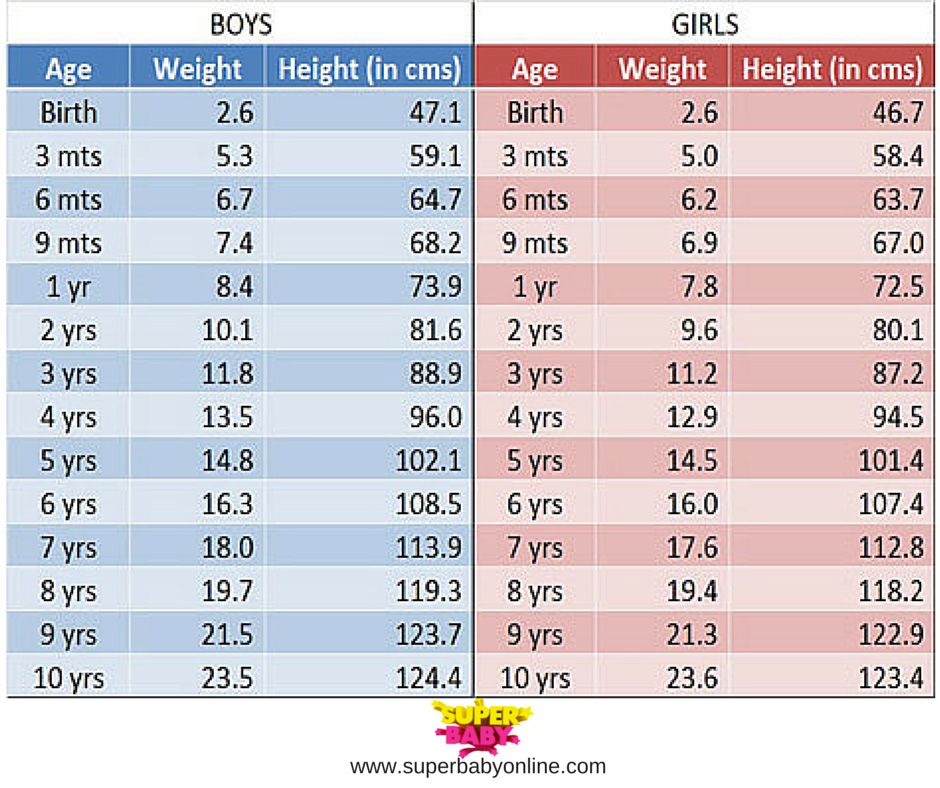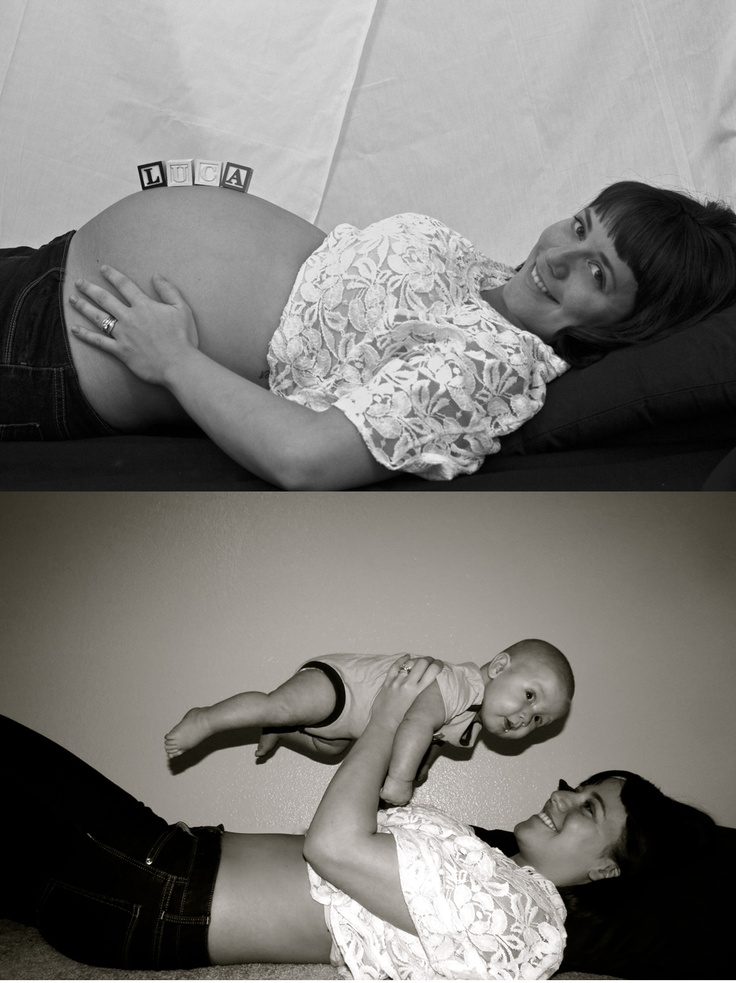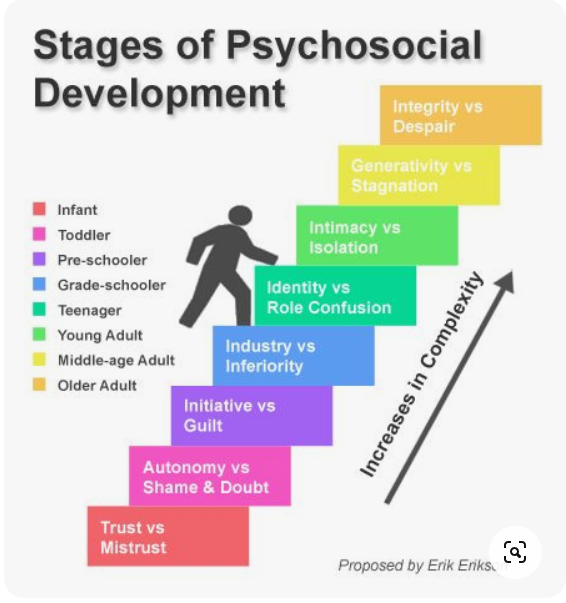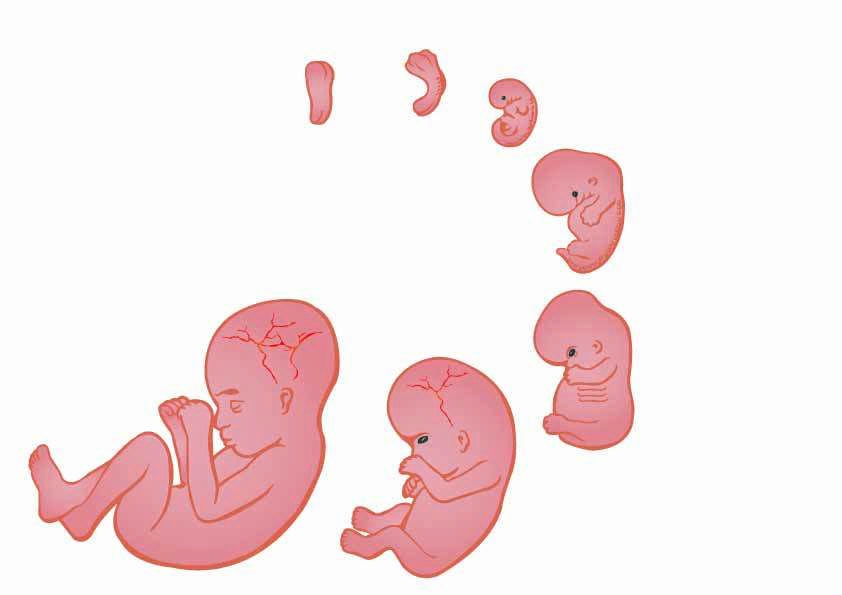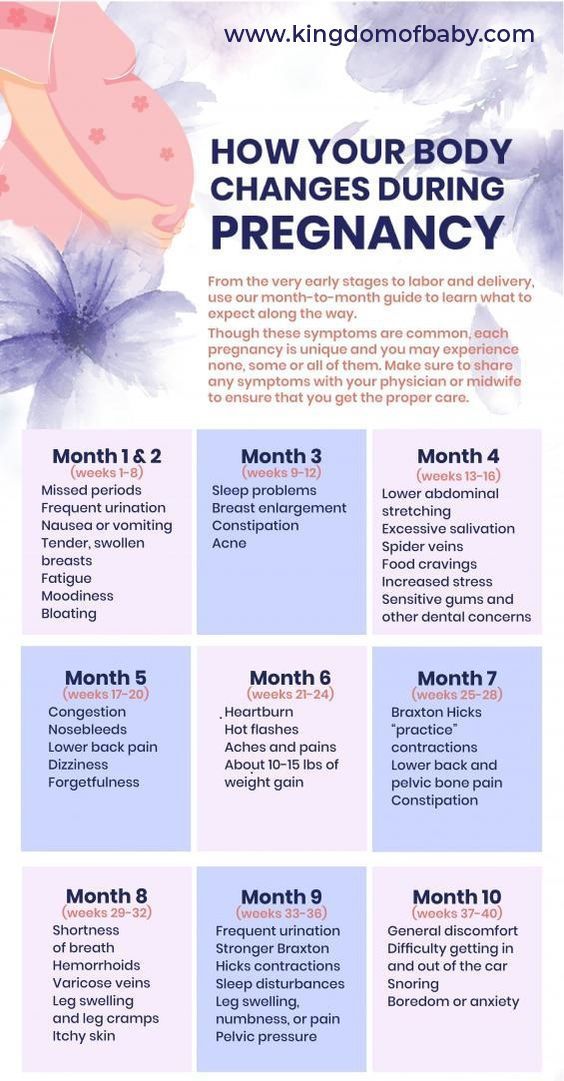Average weight for 12 week old baby
Average baby weight: Chart and development
Weight is one indicator of a baby’s physical development. While all children develop at different paces, knowing the average baby weight by month can help caregivers track overall growth.
First, it is worth noting that average weight is not “normal” weight. Just like adults, babies come in all shapes and sizes. If a baby’s weight is in a lower percentile, this does not necessarily signal a problem with their growth or physical development. With this in mind, using a weight chart can help a person generally track their baby’s growth.
The Centers for Disease Control and Prevention (CDC) recommend using the World Health Organization (WHO) weight chart for babies up to 2 years of age.
This article describes the average weight of a baby month by month from birth. It also explores what can affect a baby’s weight.
According to the WHO, the average birth weight of a full-term male baby is 7 pounds (lb) 6 ounces (oz), or 3. 3 kilograms (kg). The average birth weight of a full-term female is 7 lb 2 oz, or 3.2 kg.
The average weight of a baby born at 37–40 weeks ranges from 5 lb 8 oz to 8 lb 13 oz. This is 2.5 to 4 kg.
At delivery, experts consider a low birth weight to be less than 5 lb 8 oz, or 2.5 kg.
It is common for babies to lose around 10% of their weight shortly after birth. This decrease is mostly due to fluid loss and usually nothing to worry about. Most babies gain back this weight within 1 week.
Weight charts can help a person tell what percentile their baby’s weight falls into. For example, if their weight is in the 60th percentile, it means that 40% of babies of the same age and sex weigh more, and 60% of these babies weigh less.
This does not necessarily mean that any baby weighs too much or too little. It can simply indicate where a baby’s weight falls on a spectrum.
The chart below shows baby weights in the 50th percentile. This is the average weight. Male babies tend to weigh a little more than female babies, so the chart is divided by sex.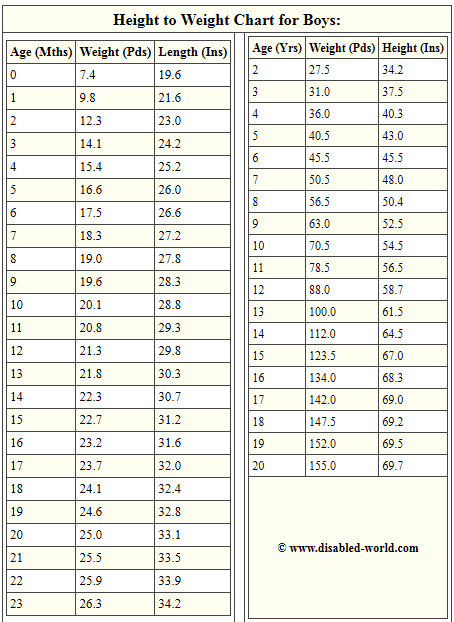
| Baby age | Female 50th percentile weight | Male 50th percentile weight |
| Birth | 7 lb 2 oz (3.2 kg) | 7 lb 6 oz (3.3 kg) |
| 1 month | 9 lb 4 oz (4.2 kg) | 9 lb 14 oz (4.5 kg) |
| 2 months | 11 lb 5 oz (5.1 kg) | 12 lb 4 oz (5.6 kg) |
| 3 months | 12 lb 14 oz (5.8 kg) | 14 lb 1 oz (6.4 kg) |
| 4 months | 14 lb 3 oz (6.4 kg) | 15 lb 7 oz (7.0 kg) |
| 5 months | 15 lb 3 oz (6.9 kg) | 16 lb 9 oz (7.5 kg) |
| 6 months | 16 lb 1 oz (7.3 kg) | 17 lb 8 oz (7.9 kg) |
| 7 months | 16 lb 14 oz (7.6 kg) | 18 lb 5 oz (8.3 kg) |
| 8 months | 17 lb 8 oz (7.9 kg) | 18 lb 15 oz (8.6 kg) |
| 9 months | 18 lb 2 oz (8.2 kg) | 19 lb 10 oz (8.9 kg) |
| 10 months | 18 lb 11 oz (8.5 kg) | 20 lb 3 oz (9.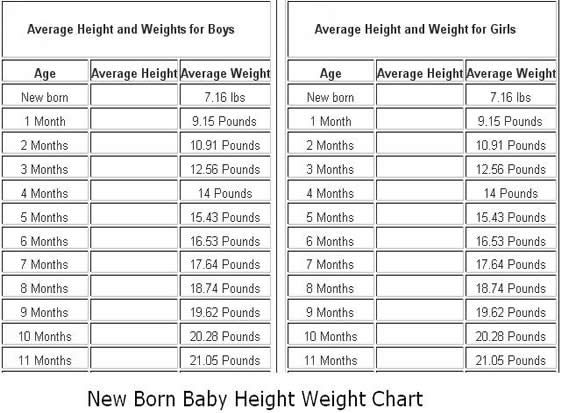 2 kg) 2 kg) |
| 11 months | 19 lb 4 oz (8.7 kg) | 20 lb 12 oz (9.4 kg) |
| 12 months | 19 lb 12 oz (8.9 kg) | 21 lb 4 oz (9.6 kg) |
Babies grow and gain weight the fastest within the first 6 months of life. Although this can vary, babies tend to gain around 4–7 oz, or 113–200 grams (g), per week in the first 4–6 months.
Weight gain then slows slightly, with an average gain of around 3–5 oz (about 85–140 g) per week when the baby is 6–18 months. On average, babies triple their birth weight by their first birthday.
Growth patterns do not follow a clear schedule, however.
Some babies gain weight steadily and stay in the same percentile, or close to it, for several months. Others gain weight rapidly, signalling a growth spurt, which can happen at any time. This may move a baby into a new weight percentile.
It is important not to focus on weight as the only indicator of physical development. Other measurements of this development include the baby’s length and head circumference.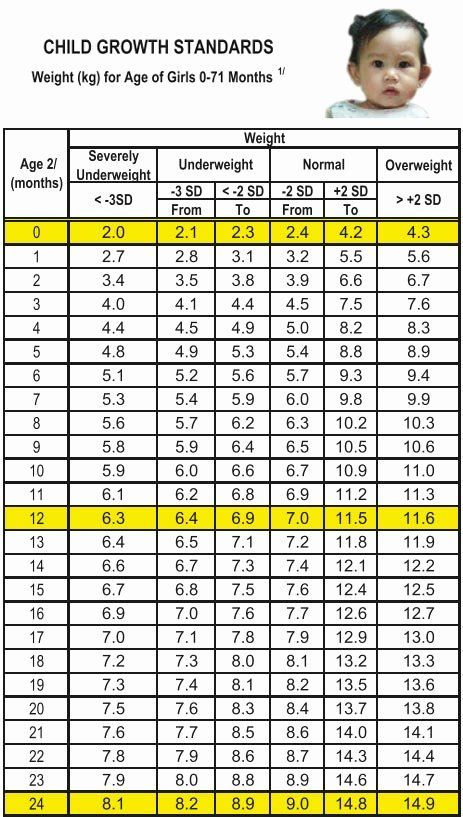
Considering all three measurements gives doctors an idea about how the baby is growing, compared with other babies of the same age and sex.
Meanwhile, it is also important to keep other developmental milestones in mind. Various checklists of milestones by age are available, including one from Pathways.org, which is endorsed by organizations such as the American Academy of Pediatrics and the National Association of Pediatric Nurse Practitioners.
For anyone looking for more information about what influences the weight of a baby, several factors can be involved, including:
Sex
Male newborns tend to be bigger than female newborns, and they typically gain weight a little faster during infancy.
Nutrition
Weight gain and growth rates can also depend on whether the baby consumes breast milk or formula.
The American Academy of Pediatrics notes that breastfed babies gain weight and grow faster than formula-fed babies during the first 6 months.
However, that rate can shift during the next 6 months. Breastfed babies may gain weight and grow more slowly than formula-fed babies when they are aged 6 months to 1 year.
Breastfed babies may gain weight and grow more slowly than formula-fed babies when they are aged 6 months to 1 year.
Medical conditions
Underlying health issues can cause a baby to gain weight more slowly. For example, babies with congenital heart irregularities may gain weight at a slower rate than babies without this condition.
Health issues that affect nutrient absorption or digestion, such as celiac disease, may also lead to slow weight gain.
Prematurity
Babies born prematurely may grow and gain weight more slowly during their first year than babies born at full term.
However, many babies born prematurely gain weight rapidly and “catch up” by about their first birthday.
The average birth weight for full-term male babies is 7 lb 6 oz, or 3.3 kg. For female babies born full-term, the average birth weight is 7 lb 2 oz, or 3.2 kg.
Baby weight charts can help a healthcare team track a baby’s physical development by comparing the baby’s weight with the weights of others of the same age and sex.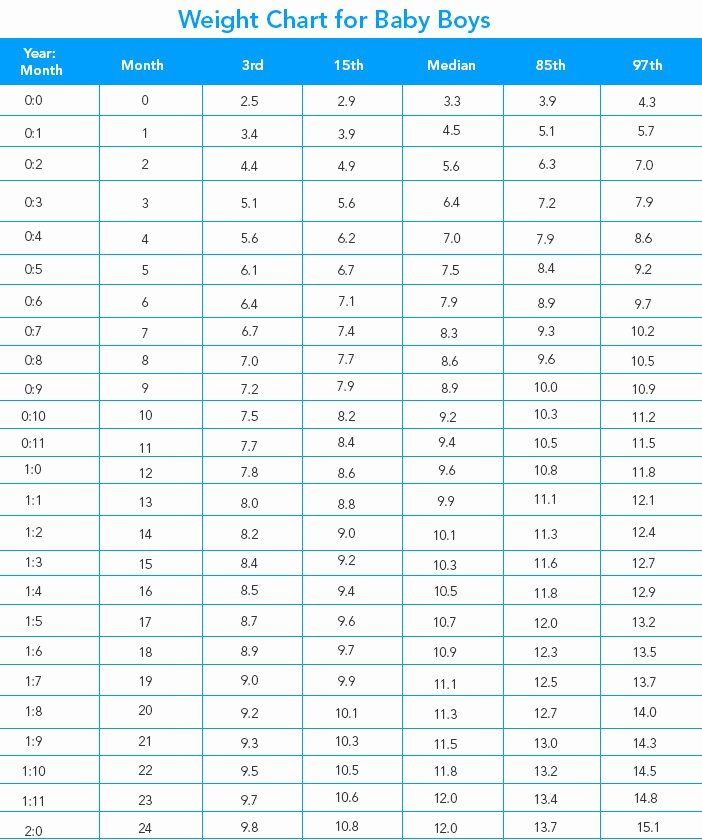
Still, a doctor usually looks for steady growth, rather than a target percentile, when assessing a baby’s physical development. And even if a baby’s weight is in a lower percentile, they will not necessarily be a small adult — just as longer babies do not necessarily become tall adults.
Knowing about average weights by month can help people gauge their babies’ physical development, but doctors also look for other important indicators, such as length and head circumference.
Healthcare professionals also take into account whether a baby is generally hitting other milestones on time. And by taking a detailed medical history, they can rule out any medical conditions or nutritional considerations that may be preventing a baby from gaining weight appropriately.
Average baby weight: Chart and development
Weight is one indicator of a baby’s physical development. While all children develop at different paces, knowing the average baby weight by month can help caregivers track overall growth.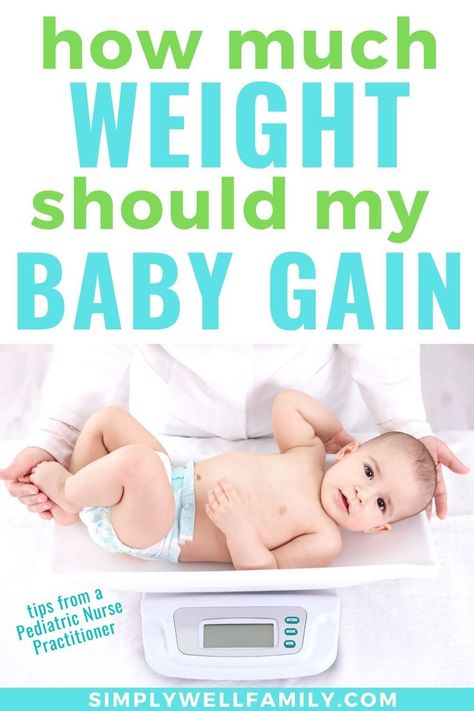
First, it is worth noting that average weight is not “normal” weight. Just like adults, babies come in all shapes and sizes. If a baby’s weight is in a lower percentile, this does not necessarily signal a problem with their growth or physical development. With this in mind, using a weight chart can help a person generally track their baby’s growth.
The Centers for Disease Control and Prevention (CDC) recommend using the World Health Organization (WHO) weight chart for babies up to 2 years of age.
This article describes the average weight of a baby month by month from birth. It also explores what can affect a baby’s weight.
According to the WHO, the average birth weight of a full-term male baby is 7 pounds (lb) 6 ounces (oz), or 3.3 kilograms (kg). The average birth weight of a full-term female is 7 lb 2 oz, or 3.2 kg.
The average weight of a baby born at 37–40 weeks ranges from 5 lb 8 oz to 8 lb 13 oz. This is 2.5 to 4 kg.
At delivery, experts consider a low birth weight to be less than 5 lb 8 oz, or 2.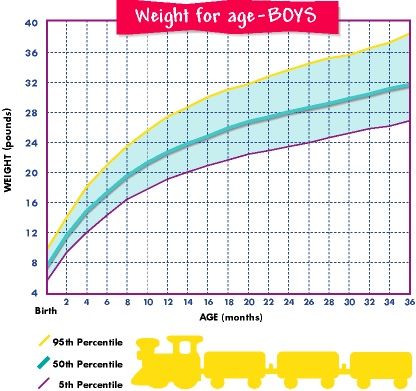 5 kg.
5 kg.
It is common for babies to lose around 10% of their weight shortly after birth. This decrease is mostly due to fluid loss and usually nothing to worry about. Most babies gain back this weight within 1 week.
Weight charts can help a person tell what percentile their baby’s weight falls into. For example, if their weight is in the 60th percentile, it means that 40% of babies of the same age and sex weigh more, and 60% of these babies weigh less.
This does not necessarily mean that any baby weighs too much or too little. It can simply indicate where a baby’s weight falls on a spectrum.
The chart below shows baby weights in the 50th percentile. This is the average weight. Male babies tend to weigh a little more than female babies, so the chart is divided by sex.
| Baby age | Female 50th percentile weight | Male 50th percentile weight |
| Birth | 7 lb 2 oz (3.2 kg) | 7 lb 6 oz (3.3 kg) |
| 1 month | 9 lb 4 oz (4.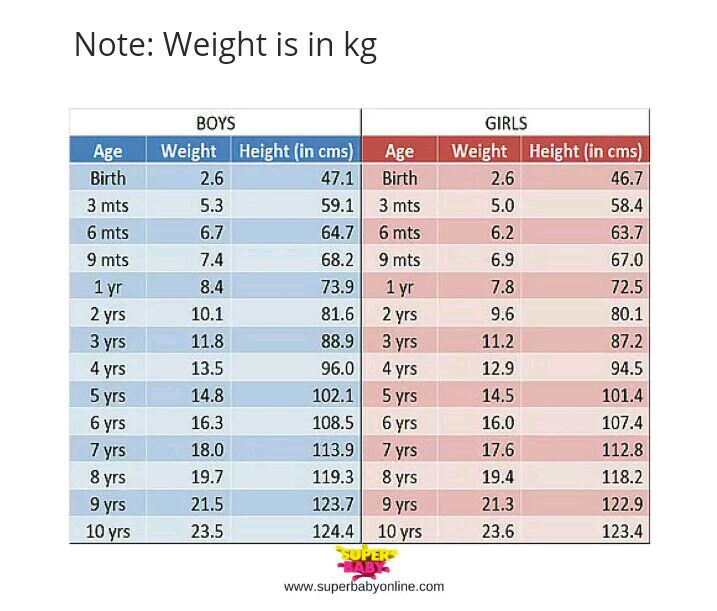 2 kg) 2 kg) | 9 lb 14 oz (4.5 kg) |
| 2 months | 11 lb 5 oz (5.1 kg) | 12 lb 4 oz (5.6 kg) |
| 3 months | 12 lb 14 oz (5.8 kg) | 14 lb 1 oz (6.4 kg) |
| 4 months | 14 lb 3 oz (6.4 kg) | 15 lb 7 oz (7.0 kg) |
| 5 months | 15 lb 3 oz (6.9 kg) | 16 lb 9 oz (7.5 kg) |
| 6 months | 16 lb 1 oz (7.3 kg) | 17 lb 8 oz (7.9 kg) |
| 7 months | 16 lb 14 oz (7.6 kg) | 18 lb 5 oz (8.3 kg) |
| 8 months | 17 lb 8 oz (7.9 kg) | 18 lb 15 oz (8.6 kg) |
| 9 months | 18 lb 2 oz (8.2 kg) | 19 lb 10 oz (8.9 kg) |
| 10 months | 18 lb 11 oz (8.5 kg) | 20 lb 3 oz (9.2 kg) |
| 11 months | 19 lb 4 oz (8.7 kg) | 20 lb 12 oz (9.4 kg) |
| 12 months | 19 lb 12 oz (8.9 kg) | 21 lb 4 oz (9.6 kg) |
Babies grow and gain weight the fastest within the first 6 months of life.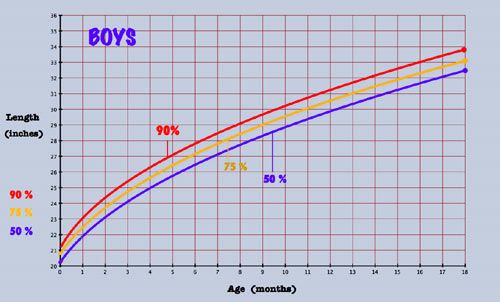 Although this can vary, babies tend to gain around 4–7 oz, or 113–200 grams (g), per week in the first 4–6 months.
Although this can vary, babies tend to gain around 4–7 oz, or 113–200 grams (g), per week in the first 4–6 months.
Weight gain then slows slightly, with an average gain of around 3–5 oz (about 85–140 g) per week when the baby is 6–18 months. On average, babies triple their birth weight by their first birthday.
Growth patterns do not follow a clear schedule, however.
Some babies gain weight steadily and stay in the same percentile, or close to it, for several months. Others gain weight rapidly, signalling a growth spurt, which can happen at any time. This may move a baby into a new weight percentile.
It is important not to focus on weight as the only indicator of physical development. Other measurements of this development include the baby’s length and head circumference.
Considering all three measurements gives doctors an idea about how the baby is growing, compared with other babies of the same age and sex.
Meanwhile, it is also important to keep other developmental milestones in mind.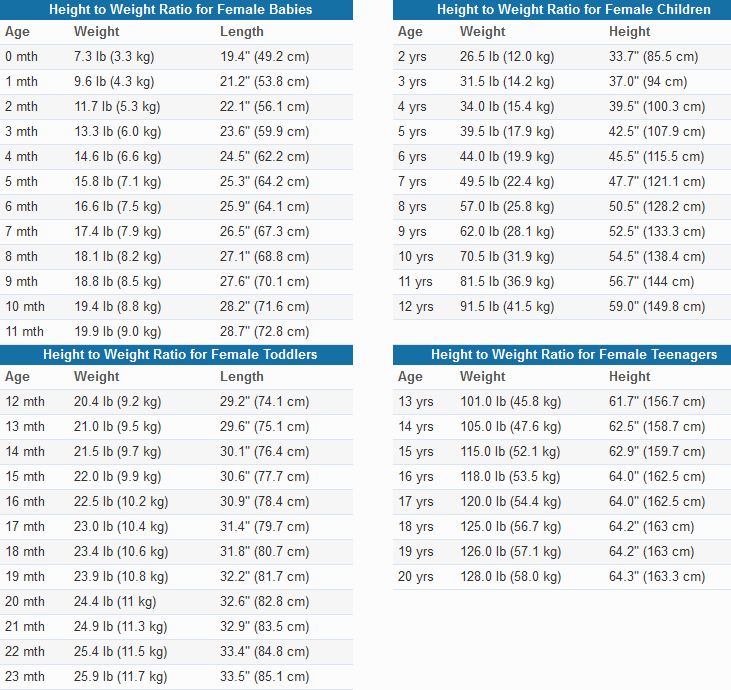 Various checklists of milestones by age are available, including one from Pathways.org, which is endorsed by organizations such as the American Academy of Pediatrics and the National Association of Pediatric Nurse Practitioners.
Various checklists of milestones by age are available, including one from Pathways.org, which is endorsed by organizations such as the American Academy of Pediatrics and the National Association of Pediatric Nurse Practitioners.
For anyone looking for more information about what influences the weight of a baby, several factors can be involved, including:
Sex
Male newborns tend to be bigger than female newborns, and they typically gain weight a little faster during infancy.
Nutrition
Weight gain and growth rates can also depend on whether the baby consumes breast milk or formula.
The American Academy of Pediatrics notes that breastfed babies gain weight and grow faster than formula-fed babies during the first 6 months.
However, that rate can shift during the next 6 months. Breastfed babies may gain weight and grow more slowly than formula-fed babies when they are aged 6 months to 1 year.
Medical conditions
Underlying health issues can cause a baby to gain weight more slowly.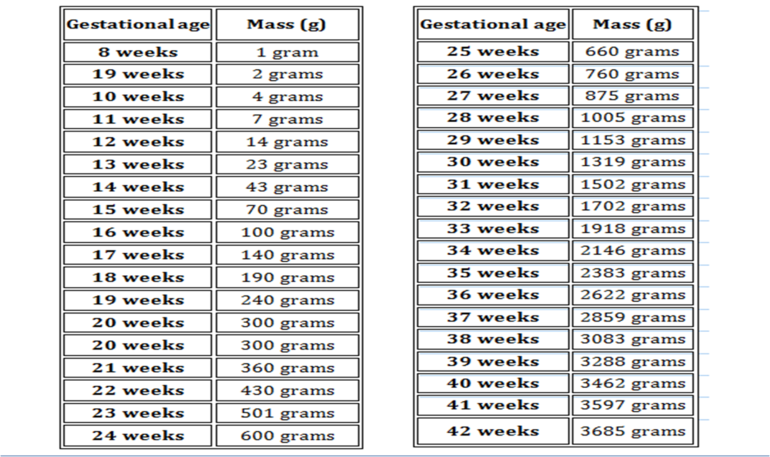 For example, babies with congenital heart irregularities may gain weight at a slower rate than babies without this condition.
For example, babies with congenital heart irregularities may gain weight at a slower rate than babies without this condition.
Health issues that affect nutrient absorption or digestion, such as celiac disease, may also lead to slow weight gain.
Prematurity
Babies born prematurely may grow and gain weight more slowly during their first year than babies born at full term.
However, many babies born prematurely gain weight rapidly and “catch up” by about their first birthday.
The average birth weight for full-term male babies is 7 lb 6 oz, or 3.3 kg. For female babies born full-term, the average birth weight is 7 lb 2 oz, or 3.2 kg.
Baby weight charts can help a healthcare team track a baby’s physical development by comparing the baby’s weight with the weights of others of the same age and sex.
Still, a doctor usually looks for steady growth, rather than a target percentile, when assessing a baby’s physical development. And even if a baby’s weight is in a lower percentile, they will not necessarily be a small adult — just as longer babies do not necessarily become tall adults.
Knowing about average weights by month can help people gauge their babies’ physical development, but doctors also look for other important indicators, such as length and head circumference.
Healthcare professionals also take into account whether a baby is generally hitting other milestones on time. And by taking a detailed medical history, they can rule out any medical conditions or nutritional considerations that may be preventing a baby from gaining weight appropriately.
12th week of pregnancy what happens to the fetus
Obstetric 12th week of pregnancy, which is counted from the first day of the last menstruation, is equal to the 10th week from the moment of conception. During this period, all the baby's systems are almost formed, nature is working on the details. This is the moment when the first trimester comes to an end. Any abnormalities in the development of the fetus are less likely. The baby is no longer so susceptible to the effects of external factors, the risk of early termination of pregnancy is behind.

What happens to the fetus?
At 12 weeks, the baby weighs an average of 15 g and is about 6 cm long. His body is still disproportionate - a large head and long limbs, but little fingers are covered with marigolds, and the eyes are not so widely spaced. In a tiny man, the upper layer of the epidermis is updated.
Interesting! The baby has facial expressions: he can close his eyes, wrinkle his nose, open his mouth.
There are other changes in the whole body:
- The pituitary, thyroid and thymus produce hormones and cells for the immune system.
- The liver produces bile and the kidneys excrete urine into the amniotic fluid.
- The inside of the ear is forming, but the auricle itself is not yet formed, although the lobe may already be visible.
- The intestine has moved to its proper place and is actively contracting
- The heart is a complete organ: 4 chambers, 2 atria and ventricle. The frequency of contraction reaches up to 160 beats per minute.
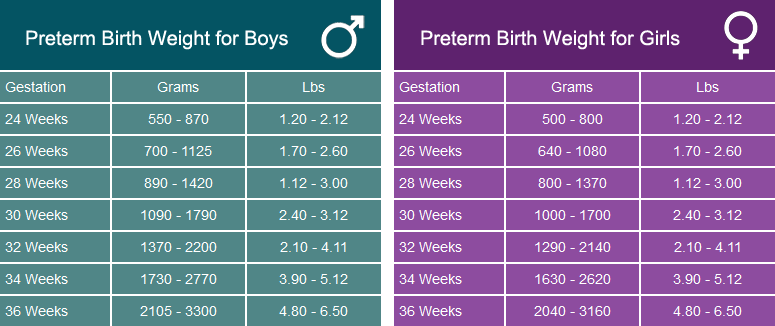
- Muscles begin to master movements.
- The neck and larynx are being formed - the baby tries swallowing movements.
- The skeleton is formed in the same way, but is still more represented by cartilaginous tissue.
- The activity of the fetus is high - it moves the legs and arms, makes grasping movements.
- The final stage of the formation of the respiratory system is also taking place. The baby's chest rises up and down, which is similar to the breathing cycle.
At the 12th week, a planned ultrasound is done, on which you can see the sex of the baby, but not always - the genitals are not yet fully formed. Diagnostics allows you to exclude fetal malformations, determine its size, find out the tone and parameters of the uterus of the expectant mother.
Important! At the 12th week, a woman will have to undergo a series of tests that are designed to detect genetic diseases. Such a survey is highly informative and safe.

What happens in the mother's body?
The function of producing progesterone, which was previously performed by the corpus luteum, is now transferred to the placenta. The uterus increases in size, but no longer presses on the bladder, so urination is less frequent than before. But the intestines feel pressure, hence constipation and flatulence appear.
It's time to change your usual clothes for more free and comfortable. It may seem to some mothers at the 12th week of pregnancy that they already feel the movement of their baby, but so far this is an illusion. Explicit tremors of tiny legs are yet to come.
Help! When choosing comfortable clothing, it is important to consider that it must be functional, made from natural hypoallergenic fabrics. A bra with wide straps is good, but softly supports the chest.
Rapid heartbeat, which is often observed in women, is associated with an increase in blood volume due to the fact that the fetus takes most of the oxygen and nutrients for its development.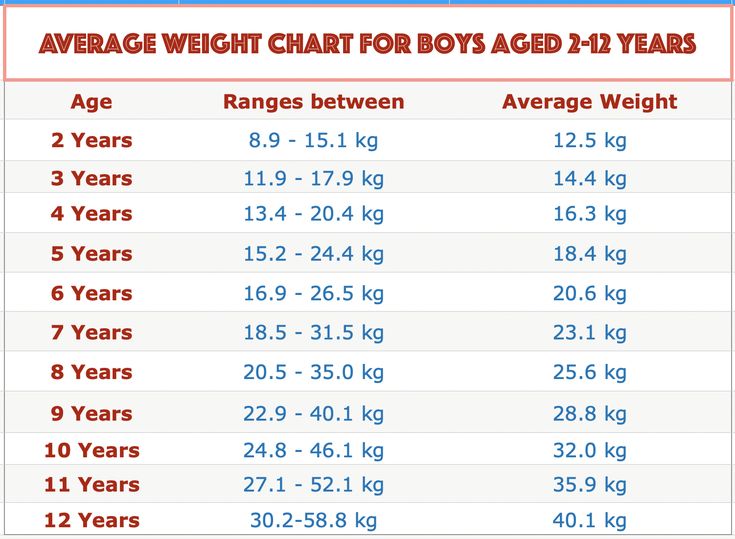 It can also increase blood pressure and cause anemia. During this period, hormonal changes sometimes lead to the formation of age spots on the body and face. But they will leave soon. Some women may begin to have problems with the condition of their hair and nails, while others, on the contrary, note improvements.
It can also increase blood pressure and cause anemia. During this period, hormonal changes sometimes lead to the formation of age spots on the body and face. But they will leave soon. Some women may begin to have problems with the condition of their hair and nails, while others, on the contrary, note improvements.
Weight gain must not exceed 3.5 kg, i.e. no more than 400 g per week. But it all depends on whether the expectant mother had excess weight before pregnancy. The mood and psychological state stabilizes somewhat, but the woman can still notice mood swings during the day. In addition, expectant mothers feel tired and overly sensitive.
Weight and height of a child by months up to a year • Table of weight norms for babies up to a year
A young mother often worries about whether her baby is developing correctly. And the weight of the child is one of the “sick” questions that often comes up on the playground.
Undoubtedly, how much a newborn is gaining weight is really important to know.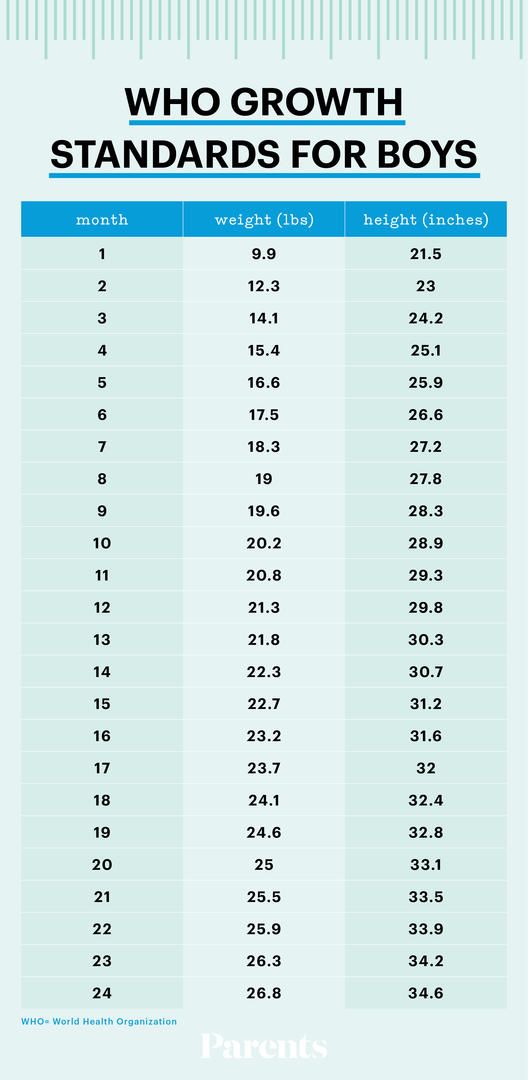 But remember that the height and weight of the child are individual indicators. And they may not always fit into beautiful statistics. Although the approximate norm for the weight of a newborn is calculated based on general values. Doctors who carry out regular weighing of a newborn also have their own guidelines.
But remember that the height and weight of the child are individual indicators. And they may not always fit into beautiful statistics. Although the approximate norm for the weight of a newborn is calculated based on general values. Doctors who carry out regular weighing of a newborn also have their own guidelines.
The table below shows the height and weight of the newborn by month. The figures take into account statistical data and recommendations of pediatricians (the discrepancy, by the way, is only 3%).
| Child's age, months | Boy, weight, g | Boy, height, cm | Girl, weight, g | Girl, height, cm |
|---|---|---|---|---|
| Newborn | 3 600 | 50 | 3400 | 49.5 |
| 1 month | 4 450 | 54.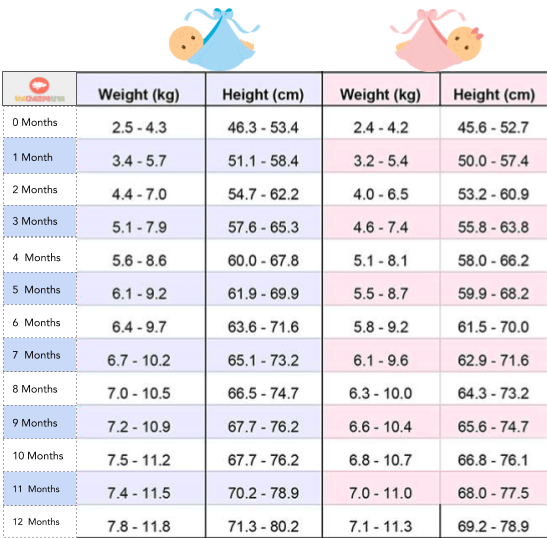 5 5 | 4 150 | 53.5 |
| 2 month | 5 250 | 58 | 4 900 | 56.8 |
| 3 month | 6050 | 61 | 5 500 | 59.3 |
| 4 month | 6 700 | 63 | 6 150 | 61.5 |
| 5 month | 7 300 | 65 | 6 650 | 63.4 |
| 6 month | 7 900 | 67 | 7 200 | 65.3 |
| 7 month | 8 400 | 68.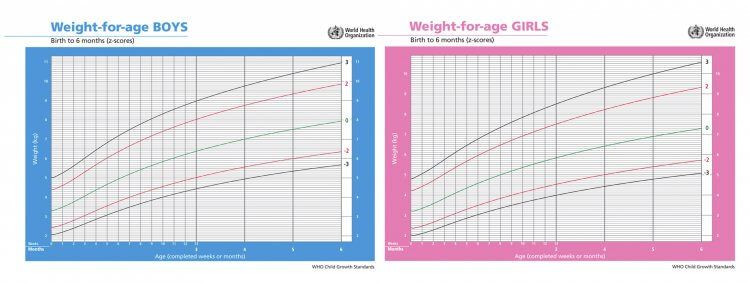 7 7 | 7 700 | 66.9 |
| 8 month | 8 850 | 70.3 | 8 100 | 68.4 |
| 9 month | 9 250 | 71.7 | 8 500 | 70 |
| 10 month | 9 650 | 73 | 8 850 | 71.3 |
| 11 month | 10,000 | 74.3 | 9 200 | 72.6 |
| 12 month | 10 300 | 75.5 | 9 500 | 73.8 |
To use the table, you should know how to weigh a newborn correctly.